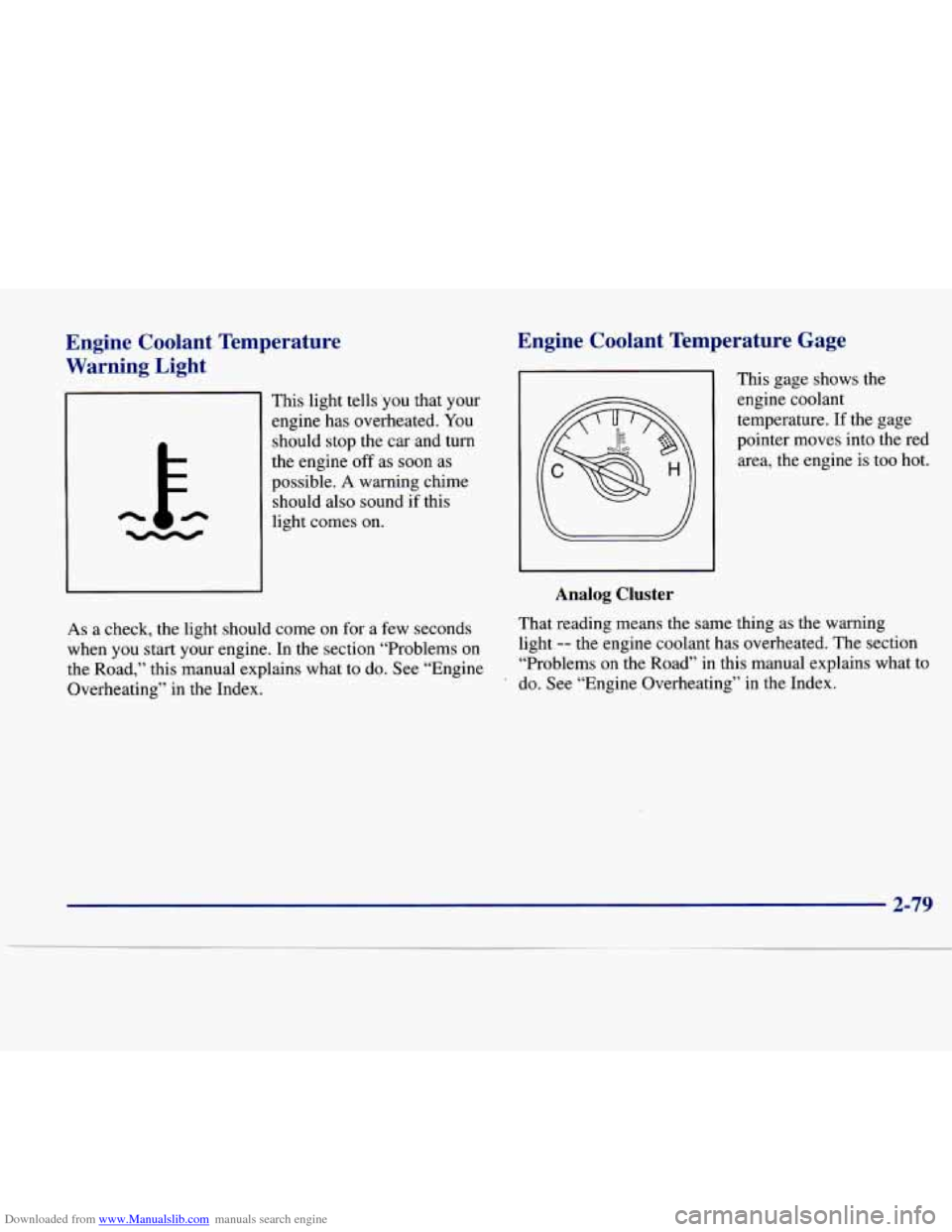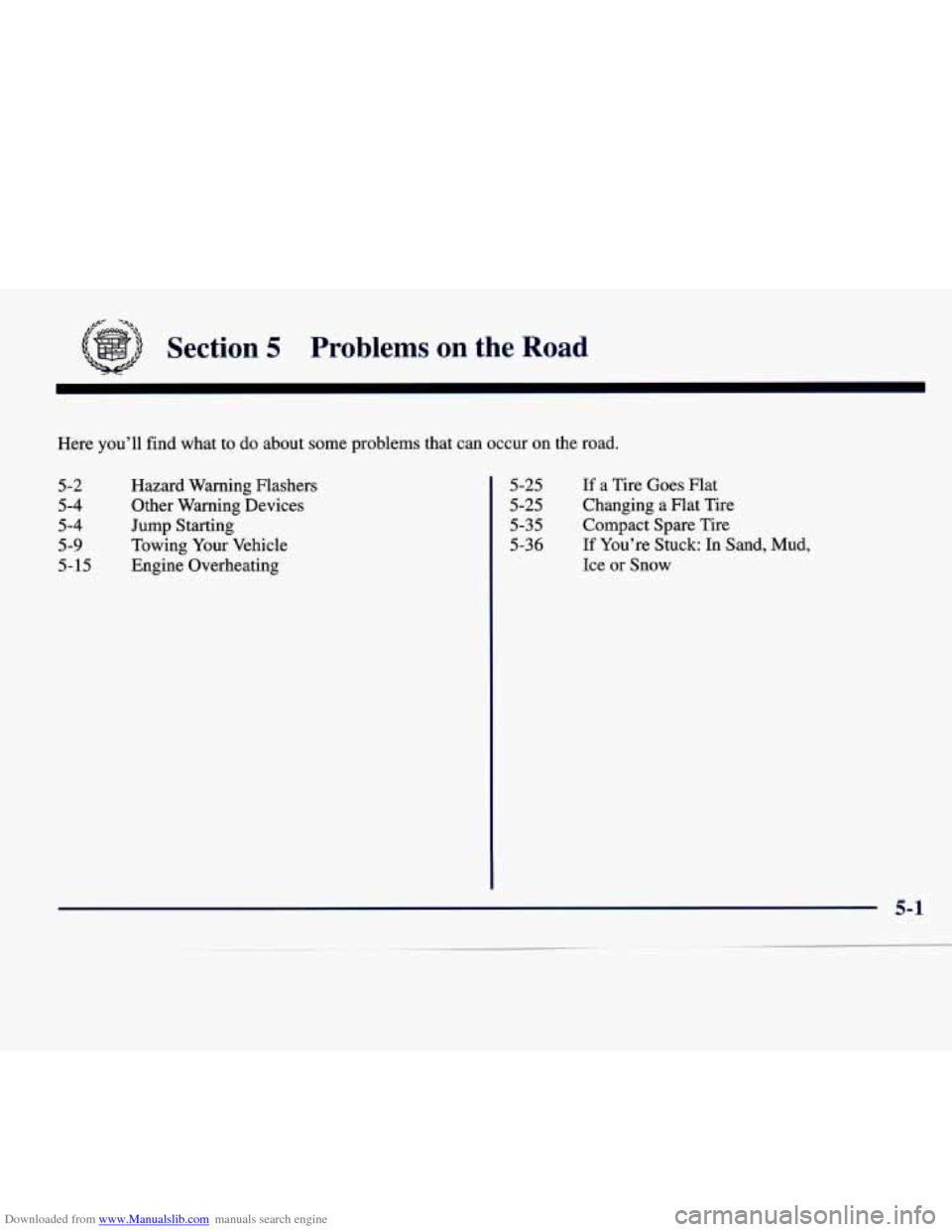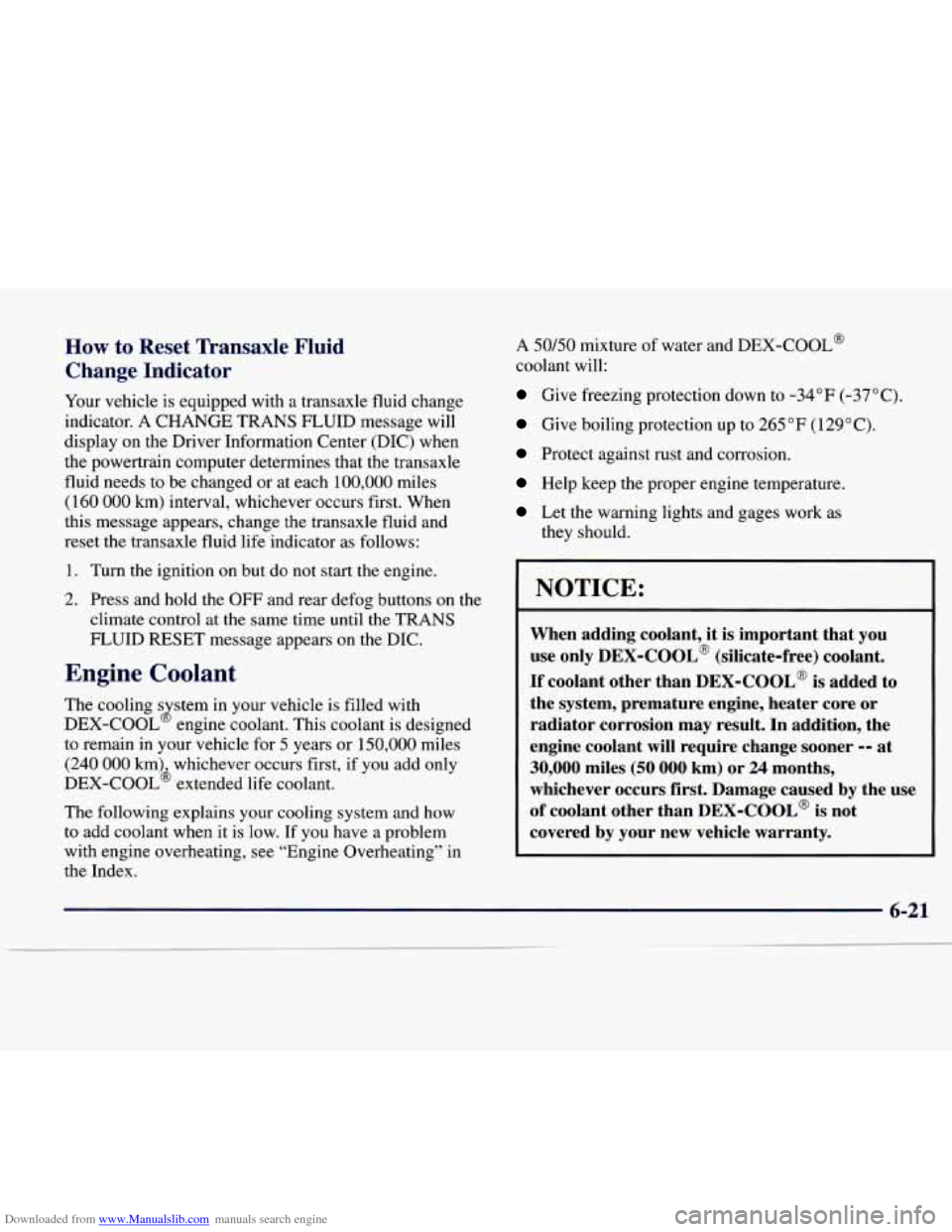overheating CADILLAC DEVILLE 1997 7.G Owners Manual
[x] Cancel search | Manufacturer: CADILLAC, Model Year: 1997, Model line: DEVILLE, Model: CADILLAC DEVILLE 1997 7.GPages: 386, PDF Size: 21.61 MB
Page 93 of 386

Downloaded from www.Manualslib.com manuals search engine FIRST (1): This position gives you even more power
than
SECOND (2). You can use it on very steep hills,
or in deep snow or mud. (If the shift lever is put in
FIRST (l), the transaxle won’t shift into gear until the
vehicle
is going slowly enough.)
NOTICE:
If your front wheels can’t rotate, don’t try to
drive. This might happen
if you were stuck in
very deep sand or mud or were up against
a solid
object. You could damage your transaxle.
Also,
if you stop when going uphill, don’t hold
your vehicle there with only the accelerator
pedal. This could cause overheating and damage
the transaxle. Use your brakes to hold your
vehicle in position on
a hill.
Parking Brake
Hold the regular brake
pedal down with your right foot and push down the
parking brake pedal with
your left foot to set the
parking brake. If the ignition is on, the PARK
BRAKE indicator light should come on. If it
doesn’t, you need to have
your vehicle serviced.
If the parking brake has not been fully released and you try to drive
off with the parking brake on, the PARK
BRAKE indicator light comes on and stays on. See
“Parking Brake Indicator Light” in the Index for
more information.
When
you move out of PARK (P) or NEUTRAL (N), if
the engine
is running, the parking brake should release. If
it doesn’t, you can manually release the parking brake.
Page 144 of 386

Downloaded from www.Manualslib.com manuals search engine Engine Coolant Temperature
Warning
Light
This light tells you that your
engine has overheated. You
should stop the car and turn
the engine
off as soon as
possible. A warning chime
should also sound if this
light comes on.
As a check, the light should come on for a few seconds
when you start your engine. In the section “Problems on
the Road,” this manual explains what to do. See “Engine
Overheating” in the Index.
Engine Coolant Temperature Gage
Analog Cluster
This gage shows the
engine coolant
temperature.
If the gage
pointer moves into the red
area, the engine is too hot.
That reading means the same thing as the warning
light
-- the engine coolant has overheated. The section
“Problems on the Road” in this manual explains what to
do. See “Engine Overheating” in the Index.
Page 156 of 386

Downloaded from www.Manualslib.com manuals search engine CHECK WASHER FLUID - 25: This message will
appear for several seconds indicating that you need
washer solvent.
CRUISE ENGAGED - 43: This message will appear for
a few seconds when you select a speed at which to cruise.
DOOR OPEN - 141: The passenger’s door or rear
doors are open
or ajar when this message appears. The
vehicle’s engine must be running and the transaxle not
be in PARK
(P) for this message to display. A chime
will also sound when the vehicle’s speed is greater than
5 mph (8.1 km/h).
DRIVER DOOR OPEN - 140: The driver’s door is
open or ajar when this message appears. The vehicle’s
engine must be running and the transaxle not be in
PARK (P) for this message to display. A chime will also
sound when the vehicle’s speed is greater than
5 mph
(8.1
km/h).
ENGINE COOLANT HOT-IDLE ENGINE - 44:
This message will appear when the engine coolant
temperature is over 248
“F (1 26 “C). To avoid added strain
on a hot engine, turn off the climate control system. Stop
and allow your vehicle to idle until it cools down or the
message is removed.
If it does not cool down, turn off the
engine and have it serviced before driving it again. Severe
engine damage can result from an overheated engine. See “Engine Overheating” in the Index,
ENGINE MISFIRE -- EASE OFF GAS
PEDAL
- 114: An engine misfire has occurred. You’ll
need to
ease off the gas pedal.
FUEL LEVEL LOW - 11: This message serves as a
warning that the fuel level in the tank
is critically low.
Stop for fuel soon.
ICE POSSIBLE - 13: This message appears when
the outside air temperature is cold enough to create icy
road conditions.
HEADLAMPS SUGGESTED - 23: If it’s dark enough
outside and the twilight sentinel control is
off, a
HEADLAMPS SUGGESTED message will display on the
DIC. This message infonns the driver that turning on the
exterior lamps is recommended even thought the
DRL are
still illuminated. (It has become dark enough outside to
require the headlamps and/or other exterior lamps.)
MONITORED SYSTEMS OK - 1: This message only
appears in the “recall” mode by pressing the RESET
button. It lets you know that no other messages are
stored or currently active.
PASS KEY NOT PROGRAMMED - 31: This
warning message displays when the PASS-Key pellet
information has not been programmed into your vehicle.
See your Cadillac dealership for service.
Page 159 of 386

Downloaded from www.Manualslib.com manuals search engine STABILITY REDUCED - 54: If you ever see the
STABILITY REDUCED message, it means there may
be a problem with your stability enhancement system.
If
you see this message, try to reset the system (stop; turn
off the engine; then start the engine again). If the
STABILITY REDUCED message still comes on,
however, it means there is a problem,
so you should see
your Cadillac dealer for service.
STARTING DISABLED DUE TO THEFT SYSTEM
REMOVE IGNITION KEY
- 33: This message will
appear when the Personalized Automotive Security
System (PASS-Key
11) senses that an improper ignition
key is being used to try to start the vehicle. Check the
ignition key for damage. If it is damaged, it may need to
be replaced. If you see no damage, clean the pellet
contacts with a soft cloth or napkin. Remove the ignition
key and wait for the DIC to display WAIT
3 MINUTES.
The instrument panel cluster will then run a timer and
change the messages to WAIT
2 MINUTES, WAIT
1 MINUTE and then START CAR. When the START
CAR message is displayed, try again to start the engine.
STOP ENGINE ENGINE OVERHEATED - 42: This
message will appear when the engine has overheated.
Stop and turn the engine
off immediately to avoid severe
engine damage. See “Engine Overheating” in the Index.
STOP ENGINE LOW OIL PRESSURE - 35: If this
message appears while the engine is running, stop the
engine and do not operate
it until the cause of low oil
pressure is corrected. Severe damage to the engine can
result. A multiple chime will also sound when this message is displayed.
THEFT SYSTEM PROBLEMCAR MAY NOT RESTART
- 34: This message means there is a problem
in the Personalized Automotive Security System
(PASS-Key
11). A fault has been detected in the system
which means that the PASS-Key
I1 system is disabled
and is not protecting the vehicle. The vehicle usually
restarts, however, you may want to take your vehicle to
a proper service center before turning
off the engine.
TOP SPEED FUEL CUT-OFF - 111: This message
will appear when the PCM senses that the maximum
speed for your Cadillac has been reached. The speed
of your vehicle will decrease several mph as the fuel
supply
is cutoff. This allows your vehicle to stay in a
stable operating range.
Page 239 of 386

Downloaded from www.Manualslib.com manuals search engine Passing
You’ll need more passing distance up ahead when
you’re towing
a trailer. And, because you’re a good deal
longer, you’ll need to go much farther beyond the
passed vehicle before you can return to your lane.
Backing Up
Hold the bottom of the steering wheel with one hand.
Then, to move the trailer to the left, just move that hand
to the left.
To move the trailer to the right, move your
hand to the right. Always back up slowly and, if
possible, have someone guide you.
Making Turns
NOTICE:
Making very sharp turns while trailering could
cause the trailer to come in contact with the
vehicle.
Your vehicle could be damaged. Avoid
making very sharp turns while trailering.
When you’re turning with a trailer, make wider turns
than normal.
Do this so your trailer won’t strike soft
shoulders, curbs, road signs, trees or other objects. Avoid
jerky or sudden maneuvers. Signal well
in advance.
Turn Signals When Towing a Trailer
When you tow a trailer, your vehicle may need a
different turn signal flasher and/or extra wiring. Check
with your Cadillac dealer. The green arrows on your
instrument panel will flash whenever you signal a turn or lane change. Properly hooked up, the trailer lamps
will also flash, telling other drivers you’re about to turn,\
change lanes or stop.
When towing a trailer, the green arrows on your
instrument panel will flash for turns even if the bulbs on
the trailer
are burned out. Thus, you may think drivers
behind you
are seeing your signal when they are not. It’s
important to check occasionally to be sure the trailer
bulbs are still working.
Driving On Grades
Reduce speed and shift to a lower gear before you start
down a long or steep downgrade. If you don’t shift
down, you might have to use your brakes
so much that
they would get hot and no longer work well.
On a long uphill grade, shift down and reduce your
speed to around
45 mph (70 km/h) or less to reduce the
possibility of engine and transaxle overheating.
Page 244 of 386

Downloaded from www.Manualslib.com manuals search engine Section 5 Problems on the Road
Here you’ll find what to do about some problems that can occur on the road.
5-2 Hazard Warning Flashers
5-4 Other Warning Devices
5-4 Jump Starting
5-9 Towing
Your Vehicle
5- 15 Engine Overheating 5-25
5-25
5-35
5-36 If
a Tire Goes Flat
Changing a Flat Tire
Compact Spare Tire
If You’re Stuck: In Sand, Mud,
Ice or Snow
Page 258 of 386

Downloaded from www.Manualslib.com manuals search engine Attach a separate safety chain around the end of each
axle inboard
of the spring.
Engine Overheating
You will find an ENGINE COOLANT HOT-IDLE
ENGINE message or a STOP ENGINE ENGINE
OVERHEATED message on the Driver Information
Center (DIC). There is also an engine temperature
warning light and/or gage on the instrument panel. See
“Engine Coolant Temperature Warning Light” or
“Engine Coolant Temperature Gage” in the Index.
Overheated Engine Protection
Operating Mode
Should a low coolant condition exist and the message
STOP ENGINE ENGINE OVERHEATED is displayed,
an overheat protection mode which alternates firing
groups
of four cylinders helps prevent engine damage.
In this mode, you will notice a loss in power and engine
performance. This operating mode allows your vehicle
to be driven to a safe place in
an emergency; you may
drive up to
50 miles (80 km). Towing a trailer in the
overheat protection mode should be avoided.
NOTICE:
After driving in the overheated engine protection
operating mode, to
avoid engine damage, allow
the engine to cool before attempting any repair.
The engine oil will
be severely degraded. Repair
the cause
of coolant loss, change the oil and reset
the oil life indicator. See “Engine Oil, When to
Change” in the Index.
. 5-15
Page 262 of 386

Downloaded from www.Manualslib.com manuals search engine If it isn’t, the coolant level should be indicated by a
CHECK COOLANT LEVEL message on the Driver
Information Center. If it is, you may have a leak in the
radiator hoses, heater hoses, radiator, water pump or
somewhere else in the cooling system. Heater and radiator
hoses, and other engine
parts, can be very hot. Don’t touch them.
If you
do, you can be burned.
Don’t run the engine if there
is a leak. If you run
the engine, it could lose all coolant. That could
cause an engine fire, and you could be burned.
Get any leak fixed before you drive the vehicle.
ICE:
Engine damage if you keep running your engine
without coolant isn’t covered by your warranty.
See “Overheated Engine Protection Operating
Mode” in the Index.
If there
seems to be no leak, with the engine on, check to
see if the electric engine fans are running.
If the engine
is overheating, both fans should be running. If they
aren’t, your vehicle needs service.
5-19
Page 304 of 386

Downloaded from www.Manualslib.com manuals search engine How to Reset Transaxle Fluid
Change Indicator
Your vehicle is equipped with a transaxle fluid change
indicator.
A CHANGE TRANS FLUID message will
display
on the Driver Information Center (DIC) when
the powertrain computer determines
that the transaxle
fluid needs to be changed or at each
100,000 miles
(160 000 km) interval, whichever occurs first. When
this message appears, change the transaxle fluid and
reset
the transaxle fluid life indicator as follows:
1. Turn the ignition on but do not start the engine.
2. Press and hold the OFF and rear defog buttons on the
climate control at the same time until the
TRANS
FLUID RESET message appears on the DIC.
Engine Coolant
The cooling s stem in your vehicle is filled with
DEX-COOL engine coolant. This coolant is designed
to remain
in your vehicle for 5 years or 150,000 miles
(240 000 km) whichever occurs first, if you add only
DEX-COOL’ extended life coolant.
The following explains your cooling system and how
to add coolant when it is low. If you have a problem
with engine overheating, see “Engine Overheating” in
the Index.
J
A 50/50 mixture of water and DEX-COOL@
coolant will:
Give freezing protection down to -34°F (-37°C).
Give boiling protection up to 265 “F (129°C).
Protect against rust and corrosion.
Help keep the proper engine temperature.
Let the warning lights and gages work as
they should.
NOTICE: ~ ~~ ~ -
When adding coolant, it is important that you
use only
DEX-COOL@ (silicate-free) coolant.
If coolant other than DEX-COOL@ is added to
the system, premature engine, heater core or
radiator corrosion may result. In addition, the
engine coolant will require change sooner
-- at
30,000 miles (50 000 km) or 24 months,
whichever occurs first. Damage caused by the use
of coolant other than DEX-COOL@ is not
covered by your new vehicle warranty.
Page 307 of 386

Downloaded from www.Manualslib.com manuals search engine Adding Coolant
If you need more coolant, add the proper DEX-COOL@
coolant mixture at the surge tank, but only when the
engine is cool.
You can be burned if you spill coolant on hot
engine parts. Coolant contains ethylene glycol,
and it
will burn if'the engine parts are hot
enough. Don't spill coolant on
a hot engine.
When replacing the pressure cap, make sure it
is tight.
Surge Tank Pressure Cap
1 NOTICE:
The surge tank cap is a 15 psi (105 kPa)
pressure-type cap and must be tightly installed to
prevent coolant loss and possible engine damage
from overheating. Be sure the arrows on the cap
line up.
If the surge tank pressure cap needs to be replaced, a
General Motors cap
is recommended.
Thermostat
Engine coolant temperature is controlled by a thermostat
in the engine coolant system. The thermostat stops the
flow of coolant through the radiator until the coolant
reaches a preset temperature.
If your thermostat needs to be replaced, a General
Motors thermostat
is recommended.
6-24